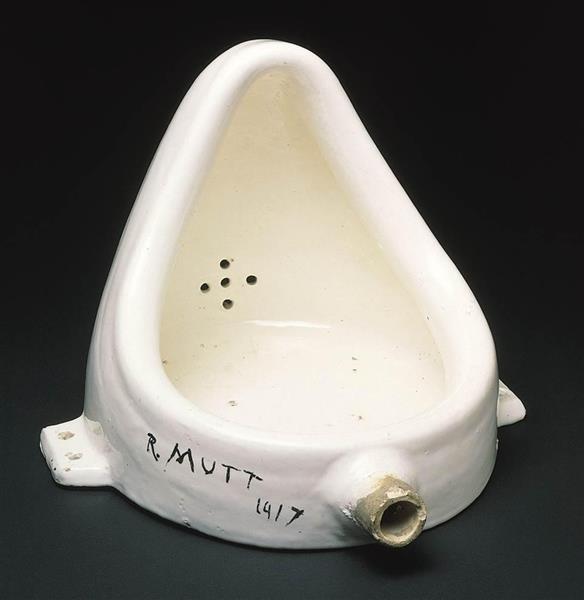I hope you are doing well with so much that is happening, I would like to contribute by telling you a bit about art so that you can clear your mind for a while. Art is something that has helped me personally a lot and in these moments that we cannot do much, I recommend that you to make art or if you are one of those who prefer to read, take advantage of these moments to read more about art as you will do now.
This post is about the famous urinal by Marcel Duchamp that many of us wonder why do they consider a urinal as art? Now I will tell you all the gossip behind this famous artwork titled "The Fountain," in order to understand a work of art we have to think about what was happening in the period of time that the work was created. So let's go back to April 2, 1917, the United States formally proclaims the war against Germany and Duchamp had arrived in New York in June 1915, he had lived there for less than two years and the political situation was tense due to the First World War.
One day Duchamp goes for a walk with two friends, one of them was Walter Arensberg who had been supporting him financially since Duchamp arrived to New York, and the other one was Joseph Stella, another artist, so the three of them were walking to Fifth Avenue through Madison Square and they reached 118 Fifth Avenue and they entered a store called J.L Mott, this store was known for selling specialized plumbing objects and there is where Duchamp bought the famous porcelain wall-mounted urinal. And now you will wonder why he purchased it? Well, he bought it knowing that this was going to cause a scandal in the Society of Independent Artists who were accepting all the artworks presented for this exhibition as a protest to the conservative and repressive attitude of the National Academy of Design towards modern art.
Duchamp considers that the medium no matter what is called a stone, canvas, wood, metal, etc, is secondary, the main thing and the most important is the idea. Since the idea is the first thing that the artist has to develop and then choose which will be the best medium to use to capture the idea. And what better way to prove your point than using a urinal. Moreover, when people see art they expect to see something aesthetic, something that is pleasing to the eye and also something that has taken a long time to do, because the more complex the process, the more appreciation we have for the final result. For example, the more realistic a painting is, the more admiration we have for the painting and this changes when we see art, as in this case, it is not a single piece nor was it made by the artist, but rather it was bought and on top of that it is zero aesthetic, you will never say that is beautiful urinary. This object is being reproduced thousands of times, there is nothing unique or special about it and that is why the viewer does not understand why is it art? what makes it special? we simply lose interest. I think we ask ourselves the wrong question because normally we ask ourselves if anyone can do it, why do they consider it art? instead, we should ask ourselves what is this artist trying to tell me through his work? why did he choose something made in masses? Why use a pseudonym? Why use something so unpleasant to the eyes? The answer is that Duchamp chose the urinal precisely because of the lack of aesthetics, the point he wanted to make with this was not about aesthetics. In the end, this work was not exhibited in public; the committee rejected it completely. However, it became the most influential work of art in the 20th century, since the ideas presented with this work influenced various artistic movements such as dadá, surrealism, abstract expressionism, pop art, conceptual art, performances, among others.
Duchamp is the person who began the debate of what is art and what is not, and he also questions what is the role that the artists play in society, he believed that their role is similar to that of a philosopher. The artist's task for Duchamp is not to generate aesthetic works but to create meaning, to make people question the observations that the artist presents in whatever medium they choose and has no other function beyond his own existence. Marcel Duchamp's influence is omnipresent in the history of modern art, he is considered the father of conceptual art. Do not think that with Duchamp modern art begins because it began long before Duchamp was born, in the 19th century in Paris, Duchamp is a product of modern art. To conclude, the original piece got lost so Duchamp did four other replicas the first one was in New York 1951, then in Paris 1953, another one in Estocolm 1963 and the last one was in Milan 1964. Also, Duchamp is among the most influential artists alongside Damien Hirst and Ai Weiwei.
I hope you have learned a lot today and have fallen a little more in love with art, comment below what you thought, what you think about Duchamp and which other artist or artwork you would like me to tell you more about in the next post. By the way, the source that says "is it really Duchamp's artwork?" it talks about this debate whether he did the artwork or if it was Elsa Hildegard but that is another story... For movie lovers, below sources, you can click and watch more about Duchamp's life!
Sources
What are you looking at? by Will Gompertz ( I highly recommend this book it talks about the 150 years of modern art!)

